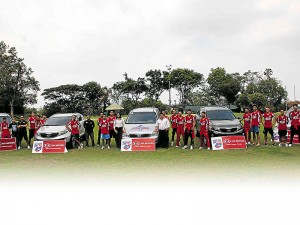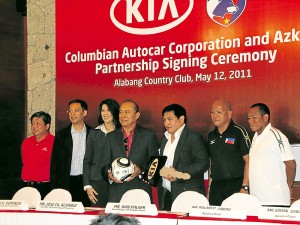
GINIA Domingo, president of local Kia distributor Columbian Autocar Corp., presents to the Azkals team their Kia service vehicles.
AFTER test-driving the 1.6-liter Kia Soul for a week, nothing could be more coincidental than to chat over lunch with the chairman of the company that distributes it, Jose Ch. Alvarez of Columbian Autocar Corp. (CAC).
“Pepito” Alvarez joined the motoring and sports media at noon at the Alabang Country Club on May 12 to sign up CAC as the official transport provider of the popular Azkals football team. Aside from CAC, Alvarez also chairs Asian Carmakers Corp. (ACC), which in 2009 was appointed by BMW Group Asia to take over the Philippine distribution of the prestigious Bavarian brand. Who else but an auto industry veteran like Pepito Alvarez can successfully juggle two very disparate brands—the low-cost Korean Kia and the premium-priced German BMW?
Competing in both the affordable segment and the luxury car niche has given Alvarez unique insight into the progress of automotive technology. “I never thought that Kia would ever reach this high level of quality,” he confided. “Now, all the technology of German cars can be found in Kia.” He was particularly impressed with the performance of Kia cars when he visited recently the 2.8-mile oval test track shared by Hyundai Motor Co. and Kia in South Korea (Hyundai owns 35 percent of Kia.)
Yet he said he had never doubted the sturdiness of Kia cars. He talked about a friend who owns a 10-year-old Sorento and wants to keep it because he hasn’t had to change anything except the tires. (I myself remember seeing a Kia Pride driving through knee-deep floodwaters in Las Piñas in 1995 without faltering.)

COLUMBIAN Autocar Corp. chairman Pepito Alvarez (fourth from left) and Azkals team manager Dan Palami exchange symbolic gifts during the recent press conference announcing Kia as the team’s official vehicle at the Alabang Country Club. Looking on are, from left, CAC marketing services head Palermo Soriano, CAC VP for marketing Dodie Gañac, CAC president Ginia Domingo and Azkals assistant coaches Rolando Pinero and Edwin Cabalida.
FIRST ASSEMBLER
Reminiscing, Alvarez said that he was the first assembler of Kia cars outside Korea. “In 1991, no one wanted to touch the Kia brand,” he recalled. “We assembled and introduced the Kia Pride and then the K2700 light commercial vehicle.” Now, CAC has 54 dealerships and sales outlets nationwide that market 10 Kia models: the Picanto (which replaced the Pride), Rio, Carens, Forte sedan, Forte Koup, Carnival, Sorento, Sportage, Mohave and Soul. Most are imported CBUs, but CAC is opening a new assembly plant soon that will presumably produce a few of these models. Alvarez revealed that the new plant will assemble a vehicle to compete with the Hyundai Grand Starex, currently the best-selling minivan in the country.
In 2009, CAC was recognized as the number one Kia distributor in the Asia-Pacific region. Why, then, is CAC not yet offering the all-new 20ll Sportage compact SUV, which has earned rave reviews abroad? At present, CAC has only one demo unit of the new Sportage. Alvarez explained that the Sportage—especially the CRD variant—is selling so well globally that production cannot keep up with demand. He claimed not to know when the new Sportage will be launched here, nor the all-new Picanto.
“I don’t meddle with details,” he said, holding in front of him a copy of the welcome remarks that had been prepared for him. “I give the presidents of my companies a free hand.” He added that he merely expects his CEOs to deliver a higher sales report at year-end. Asked how many business enterprises he owns, Alvarez, who is vice president of the Chamber of Automotive Manufacturers of the Philippines, Inc. (Campi), replied vaguely that he can’t keep track of all except his car companies which, aside from CAC and ACC, include a Nissan firm.
JOLTED
Alvarez jolted the auto industry earlier this year when he simultaneously appointed two women to head CAC and ACC, respectively: former Ford Philippines Sales AVP Ginia Domingo succeeded Felix Mabilog Jr. who retired last February, while ACC marketing director Maricar Parco replaced outgoing ACC president Bobby Rosales.
At the 2010-2011 Car of the Year Awards Night last April, newly installed CAC president Ginia Domingo accepted the Best Subcompact Crossover trophy for the 1.6 Kia Soul LX. In 2009, the 2.0-liter Kia Soul EX (P1.320M) won the same category award. Having already written about the Soul 2.0 EX (“Chutzpah from Seoul,” Sep. 30, 2009), let me just mention the differences. The P899,000 Soul 1.6 LX has the same dimensions, wheelbase and ground clearance as the 2.0 EX but not the latter’s roof rails, fog lamps and body graphics.
The Gamma 1.6 DOHC 16-valve engine also has a 4-speed automatic transmission and CVVT but no catalytic converter and produces 124 ps compared to the 2.0 EX’s 142 ps. Max torque is 15.9 kg-m/4200 rpm while the EX’s is 19.0 kg-m/4600 rpm. The 1.6 LX’s brakes on its 16-inch alloy wheels are ventilated discs in front and drums at the rear while the 2.0 EX has disc brakes on all four 18-inch wheels. The suspension is the same—front independent coil springs and coupled torsion beam at the back. But while the EX has dual airbags, the LX only has one. Both have ABS, a CD, MP3 integrated AM/FM with AUX-in and USB, but the 2.0 EX has eight speakers while the 1.6 LX only has six. The interior of the 1.6 LX is plainer than the 2.0 EX’s, which has a blood-red color theme, mood-reflecting lights and speakers that pulse to the beat of the music.
Despite its lesser specs, the 1.6 Soul LX is frisky, funky and comfy enough—unless you want to pay Pepito Alvarez the P421,000 price difference.

